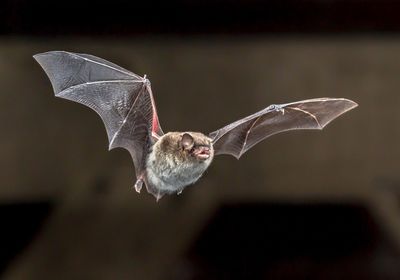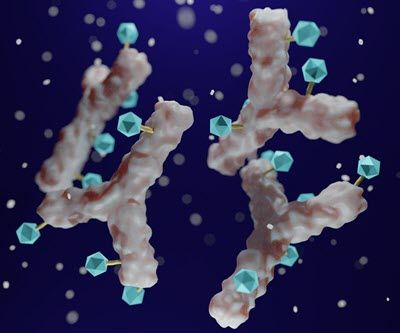ABOVE: Daubenton’s bat (Myotis daubentonii) © ISTOCK.COM, CREATIVENATURE_NL
Bats are highly unusual creatures. They’re the only mammals with the gift of powered flight; different species have adapted to feast on a wide variety of foods ranging from mosquitoes to fruit to blood; and, as probes into the origin of the COVID-19 pandemic emphasize, they can harbor myriad viruses that are dangerous or fatal to other mammals without getting sick themselves.
According to research published today (November 23) in Science Advances, bats’ ability to survive as so-called viral reservoirs may stem in part from unique mutations, including the duplication of the gene encoding an antiviral protein called protein kinase R (PKR). That second copy stems from an ongoing evolutionary “arms race,” according to the study, resulting in bats’ adaptation to and seeming immunity from a wide range of viruses over the course of their evolutionary history.
“The biggest surprise to me is the extra copies of PKR in the genomes of some bat species,” study coauthor Nels Elde, a geneticist at the University of Utah and the Howard Hughes Medical Institute, tells The Scientist over email. “Even cooler is the new evidence that these copies diverge and can become less vulnerable to virus-encoded inhibitors of PKR. It looks like two PKRs can be better than one.”
See “Are Climate-Driven Shifts in Bat Diversity to Blame for COVID-19?”
The researchers set out to identify how genetic similarities among bats, as well as differences between bats and other vertebrates, influenced their viral immunity. Specifically, they searched genomes for sequences encoding PKR; study coauthor Stéphanie Jacquet, an evolutionary biologist at Claude Bernard University Lyon 1 in France, explains in an email that the team chose it for the comparison because it is conserved across invertebrates and important to immunity.
Focusing on 33 of the more than 130 different species of mouse-eared bats (genus Myotis), the researchers first had to sequence and assemble the genomes of 15 bat species, as bat genomes are particularly scarce in the literature.
To me these results are another ‘aha’ as to the possible mechanisms into how and why bats are so cool!
—Riley Bernard, University of Wyoming
“We are still in early days sampling bat genetic diversity for comparative studies of modern species,” says Elde. “In the meantime, we have to do some off roading and collect nucleic acids from bat species to get datasets that give us insight into evolutionary signals like the ones found in this study for PKR.”
With that genomic data in hand, the researchers found that the gene EIF2AK2, which encodes PKR, rapidly evolved and underwent at least one duplication event early enough in bats’ evolutionary history that the extra copy was present in every species they sampled. Some species had more than two copies of EIF2AK2; or closely related sequences, they found, many of which encoded paralogs of PKR and share its primary function as a frontline defense against viral invaders that blocks the translation of viral DNA and RNA. Comparing these sequences to those of humans, mice (Mus musculus), cows (Bos taurus), and dogs (Canis lupus familiaris), the team found that PKR duplication is indeed unique to bats.
See “Bat Coronaviruses May Infect Tens of Thousands of People Yearly”
PKR’s unique trajectory in the animals “suggests that while bats have evolved to tolerate some viruses, they have also evolved to efficiently control viral infections—in response to past pathogenic viruses,” Jacquet says.
The bat-virus arms race
To test the function of bats’ multiplicity of PKRs, the researchers gene-edited yeast to produce various bat PKRs or its orthologs, then exposed the cells to known kinase antagonists taken from bat-infecting viruses, including poxviruses, herpesviruses, and orthomyxoviruses. They found that PKR deploys an array of mechanisms to combat various viruses, suggesting that over time, viruses evolved to counteract bats’ existing defense mechanisms, and bats evolved new-and-improved PKRs in response. Alexa Sadier, a University of California, Los Angeles, evolutionary developmental biologist who didn’t work on the study, explains that this finding is a clear-cut example of the Red Queen hypothesis, named after a character in Alice in Wonderland, which posits that a sort of evolutionary arms race occurs between predators and prey, or in this case viruses and their host, in which the selective pressure imposed by an adaptation in one imposes new pressures—and adaptations—in the other. “The host will adapt and the virus will adapt,” she says. “This is really aligned with what we know.”
Functionally, having multiple copies of the gene allowed the extras to diverge and produce proteins that are more resistant to viral inhibitors, Elde says. “Almost like a game of evolutionary hot potato where if the virus blocks one copy of PKR, the other one might be more active during infections. If the virus blocks the other, the original copy of PKR might be more effective.”
This mechanism makes sense as an explanation for why bats are seemingly immune to so many viruses, experts tell The Scientist.
“To me these results are another ‘aha’ as to the possible mechanisms into how and why bats are so cool!” University of Wyoming zoologist and physiologist Riley Bernard, who didn’t work on the study, tells The Scientist over email. “There are over 1,400 species of bats, the second most diverse group of mammals, so naturally there are going to be a lot of diseases that have coevolved with these various species over time. Not only that, but bats are so diverse in foraging type (ranging from insects and nectar to blood and fish!), body size, reproductive output, migratory capabilities. The fact that they have evolved these mechanisms to combat infection, or minimize morbidity and mortality caused by infection is not surprising.”
Amy Wray, a bat biologist who recently earned her PhD at the University of Wisconsin-Madison and who also didn’t work on the study, shares a similar sentiment: “Since bats are a diverse group and have so many unique traits—ranging from their genomes to their morphology and even their behaviors—it isn’t too surprising (but it is always very exciting) to discover another unusual adaptation in bats,” she says.
What makes bats unique?
The origins of the PKR duplication—and the reason it didn’t occur in other mammals—remain unknown. One leading hypothesis is that bats’ unusual immune capabilities may be related to the other defining trait that sets them apart from the rest of their mammalian cousins: their capacity for powered flight.
“We think that because of the flight, they have different physiological needs like high energy, these kinds of things,” suggests Sadier. “They [may] have evolved things differently for that reason.”
“Moreover, some bats could be more prone to gene duplications [than other mammals], for example because of their higher rates of transposable elements that are known to facilitate duplications,” says Jacquet.
See “Adapting with a Little Help from Jumping Genes”
Understanding the mechanisms of host-virus interactions, especially in such a prominent viral reservoir as bats, can lead to new strategies to prevent viral spillover from bats into other species, Jacquet suggests.
“We have changed the environment so much that it is up to us to think holistically, not just ‘conserve the animals’ but in a one-health approach,” Bernard says. “A healthy ecosystem leads to healthy wildlife and healthy humans.”






